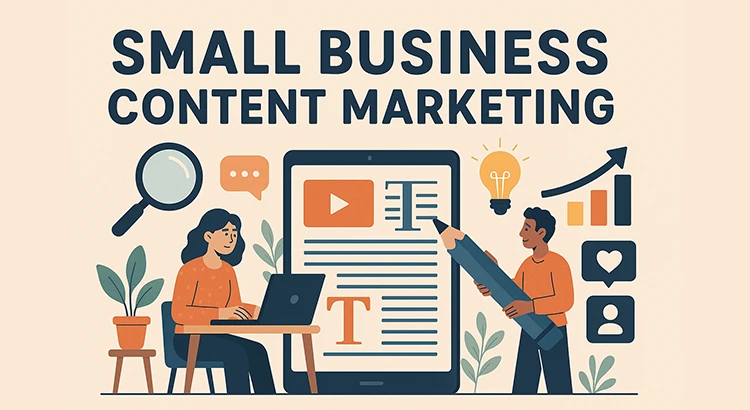Small business content marketing is one of the most efficient ways for local ventures to reach and engage with their audience. The best digital marketing companies focus on building a consistent content presence across channels. This approach not only improves discoverability but also builds trust and authority over time. This article explores top 10 practical ideas to improve your promotional efforts, even with limited resources.
Benefits of Content Marketing for Small Businesses
Investing in consistent promotional material can deliver long-term returns for any growing venture. Whether you’re running a local café or a boutique fitness brand, producing valuable materials helps you connect, educate, and convert.
1. Long-term visibility and discoverability
Unlike ads that disappear when the budget runs out, helpful articles, videos, and podcasts can drive traffic for months or even years.
2. Stronger customer relationships
Publishing stories or advice tailored to your audience builds deeper emotional connections and shows you’re not just selling, but helping.
3. Better authority and trust
Well-crafted posts that answer real questions position your business as a trusted source in your space.
4. Cost-effective lead generation
Compared to paid ads, consistent organic material has a lower cost per acquisition over time, making it ideal for ventures with limited budgets.
5. More opportunities for engagement
Social media, email newsletters, and blog comments create two-way conversations that strengthen loyalty.
How to Build a Content Marketing Strategy for Your Small Business?
The following steps will guide you through building a marketing strategy that aligns with your business goals, engages your target audience, and maximizes your resources.
1. Establish a Strong Foundation Before Creating Content
Publishing articles or social posts without a solid groundwork often leads to underwhelming results. Promotional material is only one part of a broader digital strategy. Without the right infrastructure in place, even the most well-crafted material may not perform effectively.
Before focusing on outreach, ensure the following elements are in place:
- Website performance: A slow or disorganized site can push visitors away. It’s essential to have clearly structured landing pages that showcase key offerings and guide users seamlessly.
- Consistent messaging and design: Visual elements and written copy should reflect the business’s tone and identity. Inconsistencies can reduce trust and lower engagement.
- Data and analytics setup: Tracking key metrics such as conversions, traffic sources, and user behavior is crucial for improving performance and making informed decisions.
- Conversion-ready structure: Every asset should be supported by actions such as clear CTAs, follow-up emails, or internal links to relevant products or services.
2. Document the Strategy
Publishing material without a clear direction often leads to inconsistent results. Posting a short video one week and a long-form article the next, without tying it back to specific business goals, can dilute the impact of marketing efforts. However, when a structured plan is documented, each piece serves a clear purpose and contributes to broader objectives.
Businesses that see the best results, including smaller ones, treat content creation as a consistent, intentional process rather than relying on guesswork. A well-documented approach begins with the following steps:
- Understand the audience: Identify who they are and what challenges they face.
- Define goals and key metrics: Clarify whether the focus is on generating leads, building awareness, or increasing conversions, and outline how success will be tracked.
- Select core themes: Choose topics that align with audience interests and business priorities.
- Decide on formats: Determine whether to concentrate on blog posts, videos, podcasts, or a mix.
- Plan distribution channels: Choose where the material will be published, such as on the website, through social media, or via email newsletters.
3. Build a Storytelling Culture
Smaller businesses often face challenges when competing with larger, well-known brands. One of the most effective ways to stand out is by making storytelling a core part of the marketing.
Rather than focusing solely on products or features, weaving real stories into marketing efforts helps create stronger emotional connections. These narratives could highlight the business’s journey, mission, values, or the passion behind the work.
Authentic storytelling goes beyond promotion. It shows the human side of the brand, encourages trust, and fosters lasting relationships with the audience.
4. Focus Content on the Right Customers
Businesses that try to appeal to everyone often miss the mark. The most successful ones concentrate on serving the audience they know best. This means focusing on a well-defined set of customer personas and tailoring material specifically to their needs.
To keep content customer-focused, consider the following:
- Define clear audience segments: Identify which groups the business is best suited to help. Understand their pain points, priorities, and goals. These insights should shape all content decisions.
- Dive deep into meaningful topics: Instead of covering every possible subject, focus on issues that matter most to the target audience. This demonstrates real understanding and builds credibility.
- Offer practical, easy-to-apply guidance: Content does not have to be lengthy or complex to be effective. Clear, concise advice that speaks directly to the audience’s challenges tends to have the greatest impact.
- Stick to a focused niche: A narrow focus can be a strength. Businesses that specialize in a particular area are often seen as more trustworthy and knowledgeable than those trying to cover too much ground.
5. Select Priority Content Formats
Just because major brands are active on TikTok doesn’t mean every business needs to follow the same path. Rather than pursuing every available format, it’s more effective to focus on what aligns with the business and its audience.
A few effective formats include:
- Blog posts
- Long-form videos on YouTube
- Social media shorts
- Email newsletters
- Podcasts
- User-generated content
6. Get Organized with Production
Before creating material, assess your budget, resources, and capacity for production.
This step helps determine how often material can be published, whether in-house or freelance help is needed, and what types of material are feasible to create.
7. Pick the Right Channels
Rather than trying to post on every platform, focus on the ones where your most valued customers are active. This approach helps avoid overwhelming yourself and ensures your messages reach the right audience.
8. Map Out a Calendar
At this stage, you should have a clear idea of the type of material you’re producing, how much is needed, and who will be handling it.
The next step is to map out your plan to ensure everything runs smoothly. A well-organized calendar saves time, boosts consistency, and helps you meet your objectives. Here’s what to include:
- Topics and keywords: Choose subjects that align with your audience’s interests and your goals
- Formats: Determine whether blogs, videos, newsletters, or podcasts work best for each topic
- Audience segment: Identify the group you are targeting (e.g., new customers or loyal ones)
- Timeline: Set publish dates, review periods, and promotion deadlines
- Team responsibilities: Clearly assign tasks for writing, editing, design, or social media management
9. Be Experimental, Not Generic
Competing with larger brands on popular topics can be challenging, especially with a smaller budget.
If you try to compete with generic material, your work may get lost in the crowd.
Instead of mimicking their approach, highlight your brand’s unique personality and explore angles that larger brands may overlook.
How?
- Take bold, experimental steps: Use humor, memes, or pop-culture references when appropriate. Instead of repeating common topics like “top 10 trends,” challenge assumptions or take a strong stance to get noticed.
- Generate original research: Conduct surveys or analyze data from your product to offer insights others can’t easily replicate. This makes your work stand out.
- Publish thought leadership copy: If someone on your team has unique expertise, encourage them to share their perspectives. Fresh insights or strong opinions can be more compelling than another generic “how-to” post.
10. Repurpose Your Best Performers
Identify high-performing material and repurpose it across different formats. Turn a blog post into a video, podcast, or social media snippet. This maximizes the value of successful material, saving time and reaching new audiences with minimal effort.
Conclusion
With a thoughtful approach and consistent execution, even smaller ventures can thrive through high-impact marketing efforts. These ten ideas are designed to help you stay focused, connect with the right audience, and build long-term momentum. Whether you’re just starting or refining your approach, this guide offers a clear path to smarter promotion.


